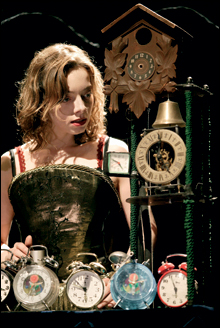Aurélia Thierrée and Coleman Lemieux at Jacob’s Pillow
By DEBRA CASH | July 3, 2007

sweetness rather than nihilism at its core. |
Children from theatrical families are often said to have been born in a trunk, but in Aurélia’s Oratorio, Aurélia Thierrée turns the cliché on its head. We first view her disembodied hand emerging from the drawer of a wooden dresser, waving a sinful cigarette, grabbing a luscious slice of cake. When a foot pokes out from a different drawer, the hand somehow manages to slip a red suede pump onto it, and the foot wriggles with an unmistakable air of satisfaction. By the time Thierrée has slung her whole body out of the bottom drawer, looking for all the world like a sultry lounge singer rising from a swoon against the lid of a piano, the “fact” that she has three legs seems a completely convincing explanation of the earlier contortionism. Those red pumps — feminine, popping with color — grow as talismanic as the potions and cookies that guided Alice on her adventures down the rabbit hole.
Aurélia Thierrée’s trippy world is the product of a collaboration with her mother, Victoria Thierrée Chaplin, who’s credited for the show’s concept and direction. Chaplin is the youngest daughter of Charlie Chaplin and Oona O’Neill (which makes Aurélia Eugene O’Neill’s great-granddaughter); she was born in California before her parents were exiled to Europe. Boston audiences with long memories may recognize the roots of Aurélia’s Oratorio in her parents’ Cirque Imaginaire and Cirque Invisible, which played at American Repertory Theatre almost 20 years ago. Performed at Jacob’s Pillow Doris Duke Studio last week, as part of what has become a smash national tour, the 75-minute piece offered surrealism with sweetness rather than nihilism at its core.
Aurélia’s Oratorio is a series of “perils of Pauline” episodes that Thierrée endures with kewpie-doll eyes and a resilient demeanor. Her mother has invented an amazing sequence of shapeshifting props and costumes — a red opera scarf that turns into a hammock and a slackrope, tasseled red velvet curtains that sway like the rigging of a storm-lashed clipper in a storm. Incongruities and swift reversals crop up without warning. Aurélia meets a street vendor who presides over what looks like a flaming cauldron, and she buys an ice-cream cone. She is menaced by a dinosaur made of lace who chomps on her leg. Voilà! — our plucky heroine grabs her knitting needles and quickly knits another to replace it.
Jamie Martinez, a dancer who’s worked with David Parsons and Mark Dendy, gets mugged by a trenchcoat that he thought was his friend; three stage assistants cross the stage, chatting, wearing shoe-shaped millinery that could have been borrowed from Terry Gilliam’s Brazil closet. The pacing is masterly, and some of the images are indelible — I gasped when Martinez, calling out Aurélia’s name, watched helplessly as she was sucked into a funnel and turned into the sand at the bottom of an hourglass. This gorgeous theatricality didn’t have to depend on special-effects technology. Old-fashioned poetry was more than adequate.
 Topics
Topics:
Dance
, Entertainment, Culture and Lifestyle, Victoria Thierree Chaplin, More  , Entertainment, Culture and Lifestyle, Victoria Thierree Chaplin, Ludwig van Beethoven, Hobbies and Pastimes, Dance, Performing Arts, Charlie Chaplin, Boston Ballet, Modern Dance, Less
, Entertainment, Culture and Lifestyle, Victoria Thierree Chaplin, Ludwig van Beethoven, Hobbies and Pastimes, Dance, Performing Arts, Charlie Chaplin, Boston Ballet, Modern Dance, Less 